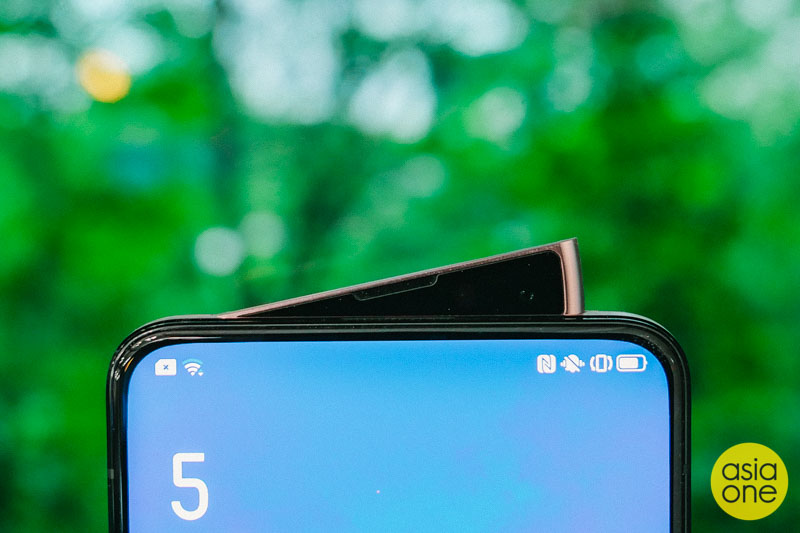Gear Review: Oppo Reno 2 is decently competent, barely premium

In the quest to achieve the holy grail of an entirely bezel-less display, smartphone makers have gone through some pretty avant-garde lengths for all-screen affairs. Out there in the market exists the likes of ugly notches (Google Pixel 3), elegant punch-holes (Huawei Nova 4), and even rotating cameras (Samsung Galaxy A80).
Oppo has its own idea of achieving the look — a method that involves tiny moving parts and things popping up. While the Chinese phone manufacturers continue to develop the world’s first under-screen selfie camera system, the brand is currently a firm believer in motorised pop-up front camera modules to deliver an uninterrupted full-view screen.
Not an entirely original idea (Vivo holds that recognition) for sure, but Oppo was the one that made shark fin selfie shooters a thing since the launch of its Reno series in April 2019.
Barely a year since then and we already have its successor: the Reno 2. Weird, I know, but I guess the improvements made in the Reno’s follow up is abundant enough to earn a title.

Case in point: a rear quad-camera array on the Reno 2, which is two more lenses than its predecessor. The four vertically-arranged lenses are embedded underneath Gorilla Glass, which covers both the front and back, creating a very smooth, lux finish and solid build quality. It’s a minor annoyance, then, that the phone doesn’t lay flat on a surface due to a tiny bump (apparently there to protect the lenses). It didn’t turn out to be an issue after all since Oppo provides a free PU leather case in the box.

Do more lenses actually equate to better photos though? The answer’s not that straightforward — we’ve seen the Pixel 3’s single-lens setup shooting better images than say, the Nokia 9 PureView with its five cameras. For the Reno2, the photos it produces are pretty rich in detail and sharp, even when shifted to 2x zoom.

Sure, the cameras work fine enough to be close to flagship-quality, so don’t expect anything spectacular. There’s a 48MP main camera, a 13MP telephoto camera, an 8MP ultrawide camera, and a 2MP bokeh lens. Combine all of that, and the images are decent enough for a mid-range phone. Because it’s made by a Chinese brand, there’s an inbuilt beauty filter that glosses everything ugly out according to your wants, and if you’ve got the AI scene recognition switched on, it’ll help adjust things like contrast, saturation and exposure according to what it detects. Which is fairly accurate.

Things the cameras aren’t so good at: barely useable 5x zoomed-in pictures and substandard night mode shots, which are abundant in smudges. Otherwise, the Reno 2 delivers in the camera department.

What I found myself liking a lot more is the pop-up shark fin selfie camera. When it comes to motorised moving parts, there’s always the worry about it being vulnerable to breakage after years of usage. At this point, the review unit we got seems pretty fresh so the metal fin feels sturdy enough when it juts out. Apparently, there’s no need to worry when the phone slips out of your hands either — drop detection capabilities will make the 16MP selfie camera retract back into safety before it hits the ground. No, I did not want to test that claim.

What the Reno2 offers too is face unlock. Meaning every time you want to look unlock the phone, the selfie camera fin rises up automatically to read your face before going back down. And it was surprisingly quick! Not to mention fun too, like it's making a physical animation every time you unlock the phone. There’s also an optical in-screen fingerprint reader if you prefer that, but face unlocking worked efficiently enough for me not to use it.
The big drawback with these motorised pop-up selfie cameras is that it renders the phone exposed to water damage. But Oppo isn’t alone in the predicament; other companies have yet to discover a way to seal the moving parts from water splashes.

But having an all-screen affair would be for nought if the display is garbage, and thankfully Oppo knows what it’s doing for the Reno 2. The phone’s AMOLED 1080p 6.5” display is a treat for the eyes, capable of producing punchy colours, crisp lines, and awesome brightness. It had no issues at all handling high-res content on YouTube or Netflix, and the respectable 4,000mAH battery meant that it could run for quite a bit, even with brightness on high.

With the display being its strongest point, it didn’t take long for me to switch to another Android launcher to make full use of the brilliant screen. By default, it runs on Oppo’s own ColorOS 6, which is… eh. The operating system emulates Apple’s own iOS and runs pretty okay on the Snapdragon 730G chip, which isn’t that fast in 2019 standards.
Other than vanilla features like an always-on clock, gesture preferences and home screen widgets, there’s nothing much else to write home about.The ColorOS Theme Store is filled dozens of wallpapers and preset themes, but they’re all rather unexciting. Nothing that you can’t fix by installing Nova Launcher though. Maybe ColorOS 7 will fare better with system-wide dark mode.
The prime question: who is the Oppo Reno 2 for? It’s clearly not up to flagship standards, but it’s a tad better than other midrange rivals like the OnePlus 7T and the Xiaomi Mi 9T. It feels premium in hand, but you won’t get premium camera quality and you definitely can’t put it anywhere near water.
Still, the Reno 2 walks gallantly in between the worlds of expensive and average, and actually displays enough competence to warrant a serious look at an $899 price point. But being neither that affordable nor hitting the $1,000 mark holds its own issues – you could get something just as decent for cheaper or save up a little bit more for an actual flagship (or flagship-adjacent) phone.
For more original AsiaOne articles, visit here.